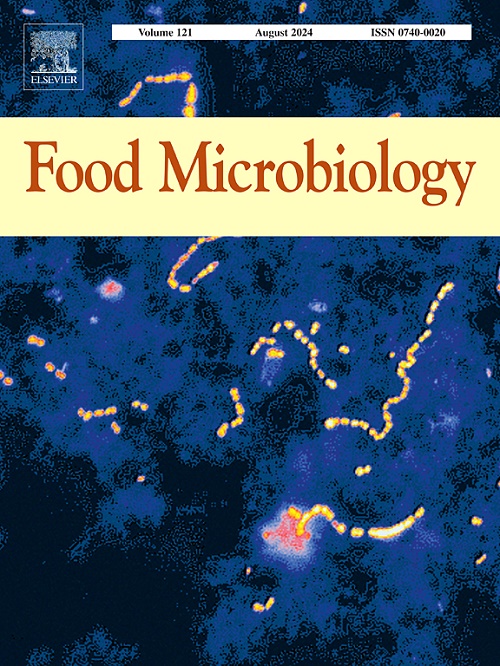亲水性守护者:22个基因缺失未改变的核心蛋白介导坂崎克罗诺杆菌的脱水抗性
IF 4.5
1区 农林科学
Q1 BIOTECHNOLOGY & APPLIED MICROBIOLOGY
引用次数: 0
摘要
阪崎克罗诺杆菌是一种臭名昭著的食源性病原体,与新生儿的严重感染有关,婴儿配方奶粉是一种常见的传播途径,因为它能够在干燥条件下存活。了解其脱水抗性的分子机制对于制定有效的防治策略至关重要。在这项研究中,我们采用比较蛋白质组学和亲水性分析来研究可能参与脱水恢复的核心蛋白。对野生型和22个敲除菌株进行蛋白质组学分析,鉴定出1354个蛋白,其中156个蛋白因其稳定的丰度谱而被定义为假定的核心蛋白。其中,两个未被鉴定的蛋白ESA_03998和ESA_01764表现出较强的亲水性,并根据信号肽分析预测其与表面相关。基因敲除ESA_03998或ESA_01764显著降低了PBS和奶粉基质的表面亲水性和长时间干燥下的存活率。此外,基于laurdan的膜流动性分析显示,突变菌株的膜刚性增加(ΔGP),表明这些蛋白质有助于在低水分条件下保持膜的水合作用和动力学。这些发现在阪崎酵母的亲水核心蛋白和膜相关的抗旱性之间建立了新的联系,为其在干燥食物环境中的持久性提供了见解,并突出了减轻婴儿配方奶粉污染的潜在目标。本文章由计算机程序翻译,如有差异,请以英文原文为准。
Hydrophilic guardians: Putative core proteins unaltered by 22 gene deletions mediate desiccation resistance in Cronobacter sakazakii
Cronobacter sakazakii is a notorious foodborne pathogen linked to severe infections in neonates, with powdered infant formula serving as a common transmission route due to its ability to survive under desiccated conditions. Understanding the molecular mechanisms underlying its desiccation resistance is crucial for developing effective control strategies. In this study, we employed comparative proteomics and hydropathy profiling to investigate putative core proteins potentially involved in desiccation resilience. Proteomic analysis of wild-type and 22 knockout strains identified 1354 proteins, of which 156 were defined as putative core proteins due to stable abundance profiles. Among these, two uncharacterized proteins, ESA_03998 and ESA_01764, exhibited strong hydrophilic properties and were predicted to be surface-associated based on signal peptide analysis. Gene knockout of ESA_03998 or ESA_01764 significantly reduced surface hydrophilicity and survival under prolonged desiccation in both PBS and milk powder matrices. Additionally, Laurdan-based membrane fluidity assays revealed increased membrane rigidification (ΔGP) in mutant strains, indicating that these proteins help preserve membrane hydration and dynamics under low-moisture conditions. These findings establish a novel link between hydrophilic putative core proteins and membrane-associated desiccation resistance in C. sakazakii, offering insights into its persistence in dry food environments and highlighting potential targets for mitigating contamination in powdered infant formula.
求助全文
通过发布文献求助,成功后即可免费获取论文全文。
去求助
来源期刊

Food microbiology
工程技术-生物工程与应用微生物
CiteScore
11.30
自引率
3.80%
发文量
179
审稿时长
44 days
期刊介绍:
Food Microbiology publishes original research articles, short communications, review papers, letters, news items and book reviews dealing with all aspects of the microbiology of foods. The editors aim to publish manuscripts of the highest quality which are both relevant and applicable to the broad field covered by the journal. Studies must be novel, have a clear connection to food microbiology, and be of general interest to the international community of food microbiologists. The editors make every effort to ensure rapid and fair reviews, resulting in timely publication of accepted manuscripts.
 求助内容:
求助内容: 应助结果提醒方式:
应助结果提醒方式:


